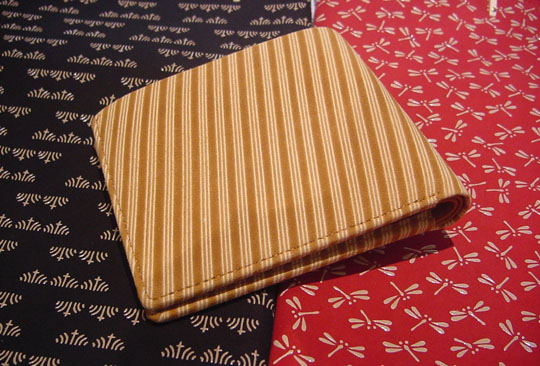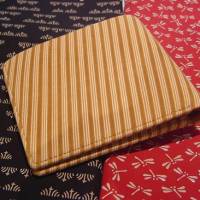Dear Alice,
A long time ago, I received a little leather coin purse as a gift from a visiting Japanese exchange student. I was intrigued by its unusual pattern, but unfortunately he couldn't explain its significance to me. Nor could any of the Japanese people I've asked since. It has always looked to me like a cross on a hill, but I'm wondering if it's culturally presumptuous of me to see Christian imagery in what is probably a traditional pattern. Can you please find out what the heck this pattern is
Rachael T, Portland, Oregon
Dear Rachael,
It was particularly nice to receive this question because I have a long-standing but seldom exercised interest in traditional Japanese designs. I even own a reference book on the subject, although I've never put it to much use. Your letter, however, gave me a compelling reason to go through it cover to cover. The book documents more than 1,000 different patterns, but unfortunately yours wasn't among them.
I was wondering what to do next when I experienced a little brain burp, suddenly remembering that I once knew someone who had a pencil case in what I was pretty sure was the same pattern. It also brought up a vague memory that his case was made from deerskin and that he had purchased it on a wine-tasting trip.
That was enough to point me toward Yamanashi Prefecture, Japan's largest wine-producing area. And with just a little more sleuthing, I discovered that one of the prefecture's dentoteki kogeihin (government-designated "Traditional Crafts of Japan") is something called "inden" — craftwork made from deerskin adorned with intricate designs in shiny lacquer. That sounded like what we were looking for, and the official designation was encouraging; crafts that meet certain standards, including being handmade and having a history of at least 100 years, qualify for government help in promotion, which suggested details, even on design, might be available.
Now that I had an idea of what to look for, I found plenty of information. But I didn't turn up anything on specific designs until I came to the Web site of a company called Inden-ya, the largest and best-known producer of inden goods. There, after just two clicks, I found the exact match of your pattern! (It's the design on the left in the photograph accompanying today's column.) Even better, I saw that the company maintains a museum. This was great news because museum curators are almost always receptive to my inquiries, no matter how off-the-wall they might be. I submitted your question and read on while I waited.
I learned there are two main decorative techniques used in making inden. The first, urushi-tsuke (lacquer application), is used to make items similar to your coin purse. Artisans dye the deerskin black, brown, red or navy blue. Then, using stencils cut from Japanese paper, they apply natural lacquer to create durable designs in both traditional and modern patterns. In the fusube method, which is actually much older, it's smoke that creates the patterns. Artisans tie deerskin around a rotating cylinder, secure paper patterns on the leather and turn the entire affair over a fire. The smoke darkens the exposed leather, creating patterns and leaving a smoky aroma that lingers even after many years of use. (The striped wallet in the center of today's photo is an example.)
I got a response from the museum, and true to pattern, it came very promptly. What's more, it came direct from Yushichi Uehara, who is not only the museum's director but president of the company and 13th in an unbroken line of inden artisans. He informed me that the pattern on your purse is called "shobu," an old pattern that goes back at least to the Sengoku Period (1467 -1573). That would include the date of what is generally considered Japan's first contact with Christianity — 1549, when Francis Xavier arrived in Kyushu — but the pattern "has no connection whatsoever with Christianity," according to Uehara. What you took to be a cross actually represents the flower of the iris plant, he said, while the curved lines on either side are its leaves.
"The iris has a very long history of use as a medicinal plant, and was used to ward off both evil and epidemics," Uehara explained. "It is also a symbol of masculine strength, which is one reason iris patterns often were used on armor and helmets." That association with health and strength is also why people still take a shobunoyu (iris bath) on May 5, adding bundles of iris leaves to their bath water. That day is now a national holiday called Kodomo no Hi ("Children's Day"), established in 1948. But it was originally Tangu no Sekku ("Boy's Festival"), and the iris bath was one way of praying for the safe growth of male children.
Samurai also favored the iris pattern because there's some powerful word play involved. Shobu is the word for "iris," but if you write it with different characters it means "militarism." Substitute yet another set of characters and it means "battle." This kind of word play, called goro awase, was highly prized in many periods of Japanese history.
Dragonfly designs were also popular with samurai, and for similar reasons. (Inden-ya's version is on the right in today's photograph.) Although the modern word for dragonfly is tombo, samurai, who admired the insect's swift and precise attacks, sometimes called them katsumushi ("winning bugs"). Hoping to invoke victory, warriors used dragonfly motifs on their armor, quivers and even swords.
"Many traditional patterns incorporate word play, or have an auspicious meaning that might not be obvious just by looking the design," Uehara explained. "That's part of why these old designs have stood the test of time and still appeal to us today."
The Inden-ya museum and main shop is located near JR Kofu station at 3-11-15 Chuo, Kofu-shi, Yamanashi-ken, (05) 233-1100. There are also branch stores in Tokyo (Aoyama 2-12-15, Minato-ku, (03) 3479-3200) and Osaka (in Shinsaibashi at 3-6-7 Bakuromachi, Chuo-ku, Osaka-shi, (06) 6243-5800). The company has a slick Web site www.inden-ya.co.jp but it's only in Japanese. To see officially designated traditional crafts of Japan all in one place, visit the Japan Traditional Craft Center on the first and second floors of Metropolitan Plaza, 1-11-1, Nishi Ikebukuro, Toshima-ku, Tokyo 171-0021, (03) 5954-6066. It's free and open 11:00 a.m. to 7 p.m. daily.




















With your current subscription plan you can comment on stories. However, before writing your first comment, please create a display name in the Profile section of your subscriber account page.